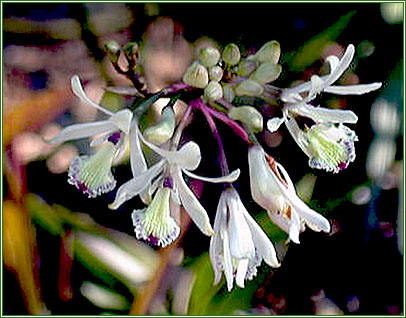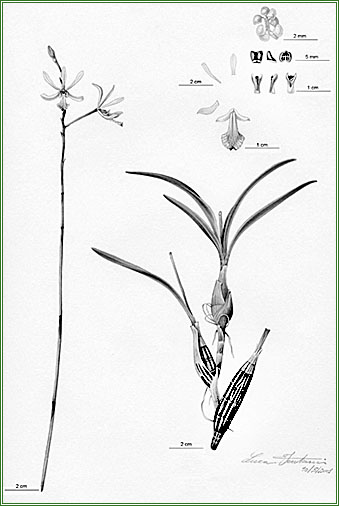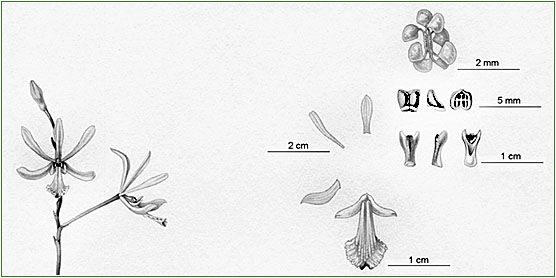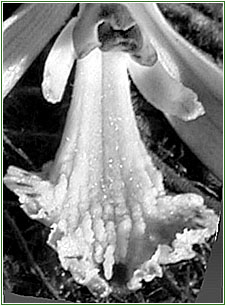|
Key-words:
Brazil, Espírito Santo, Atlantic Forest,
Orchidaceae, Pseudolaelia, P. dutrae, P.
freyi.

|
A new Pseudolaelia
species (Orchidaceae: Laeliinae) from Espírito
Santo
Abstract
This paper describes as Pseudolaelia freyi, a species which
occurs in the mountains of Espírito Santo, Brazil. This species
has some features in common with P. dutrae Ruschi. A comparison
between the those species is given as well as information about its
ecology and geographic distribution.
Withner (1993)
enumerated and presented seven species inside the genus Pseudolaelia
Porto & Brade; later, Barros (1994) transferred to this genus,
Renata canaanensis Ruschi, under the name P. canaanensis
(Ruschi) Barros; more recently, a new species, P. brejetubensis
M. Frey, has been described (Frey, 2003). All species are restricted
to the states in the Brazilian southeast: They are found, mainly,
in the states of Espírito Santo and Minas Gerais, and, in a
reduced number, in the states of Rio de Janeiro and Bahia (Pabst &
Dungs, 1975). The relief of those regions is characterized, often,
by presenting granitic inselbergs, enclosed in the Atlantic Forest,
irregularly distributed and having xerophyte vegetation and high endemism
(Porembski et al., 1998). An example of this endemism to the genus
Pseudolaelia can be done by P. citrina Pabst, only found,
until today, in the north face of one of those inselbergs, at 1 200
m altitude, in the surroundings of Imbiruçu, Mutum, Minas Gerais,
nest to the boundary of the state of Espírito Santo.
It is on those inselbergs that Michel Frey, explorer of the altitudes
in this state, found in 2001, a plant that, after analyzing, he concluded
it was a new Pseudolaelia species. This present work describes
and compares this species with the close related, P. dutrae and
gives information about its ecology and its geographical distribution.
Pseudolaelia
freyi Chiron & V.P. Castro
Ricardiana Vol IV(4) -2004 - 156:162
Planta herbacea Pseudolaelia dutrae Ruschi affinis, sed omnino minor,
pseudobulbis brevioribus tenuioribusque, foliis angustioribus, inflorescencia
nunquam majore quam 70 cm nec paniculata, floribus usque ad 20 (25)
mm diametiente, saepe albidis, labelli lobis lateralibus usque ad
2mm latis et columnam involventibus, lobo mediano sulphureo suffuso,
cum margine rosea angusta.
Typus :Brazil
, Espírito Santo, Brejetuba, Monte Feio, 20° 10’
35’’ to 20° 11’ 15’’ S, 41°
16’ 45’’ to 41° 17’ 15’’ W,
altitude 1 100-1 400 m, June 2004, M. Frey & L.C. Perim 702 (holotypus
: MBML, n°22467).
Isotypus : M. Frey & L.C. Perim 704 (LY) et M. Frey & L.C.
Perim 706 (MBML, n°22468). pink flowers specimens have also been
registered : M. Frey & L.C. Perim 703 & 707 (MBML, n°22469
& 22470), M. Frey & L.C. Perim 705 (LY) ; all of them collected
in June 2004 in the same place.
Description
Epiphyte growing on Nanuza plicata L.B. Smith &
Ayensu (Velloziaceae) or on another Vellozia species
Vandelli found; erect plant, 30-70 cm height. Rhizome semi-repent,
undulated, rigid, 5-6(7) mm diameter, pseudobulbs (3)5(7) cm distant,
6-10 internodes, recovered by scarious
apressed
short lasting sheaths. Slender roots, at about 1 mm diameter,
white, arising in number of 2 or 3 em in each internode of the rhizome.
Fusiform pseudobulbs, (5)7(8) cm tall, 15-20(25) mm diameter,
formed by 6 internodes, slightly flattened, covered by fugacious green
sheaths, smooth then plurisulcate. Distic, spread leaves 4-5(6),
inserted in the apex of the pseudobulb, reaching 18 cm length against
1,5 cm wide, the base involving the peduncle, linear-lanceolate, coriaceous,
acute apex and slightly asymmetric, 7-9 translucent nervures, the
median exceeding the abaxial side, a little folded in length, glabra,
with membranous margins and finely lacerate. inflorescence
with peduncle reaching 60 cm tall, 2,5 mm diameter at the base, purple,
with section slightly flattened, recovered with 9-10 imbricate scarious
apressed sheaths, acute at the apex, slightly carened towards up;
rachis with 6 cm tall and 1,5 mm diameter, sometimes with ramification,
exceptionally for two, often a littler later, carrying until 15 flowers
in the main axe, and 5-6(8) on each branch. Triangle-acute floral
bracts,
2,5 mm length, brown, erect. Pedicelate ovary 20 mm length (ovary
8 mm), diameter 0,6 mm, sub-perpendicular to the axe, white pinkish
becoming green purple at level of the ovary. Well opened flowers,
spread and slightly nutans. sepals white-creamy inside and
in general, pinkish at the outside, reaching 18 mm length by 4 mm
wide, glabra, with smooth margins, the dorsal is ob-oval elongated,
curved, with 5-7 nervures, the lateral are ab-long, slightly falciform,
concave, sub-retangular-apiculate at the apex. petals 18-20
mm length versus 3 mm wide, linear-oblong, clearly falciform, a little
curved at the apex, sub-rectum, glabra, with smooth margins and 3
nervures somewhat free. lip reaching r 17 mm long versus 11
mm wide at the level of the spread lateral lobes and 10 mm at the
level of the median lobe, fused to the column until the half of it,
3-lobed, composed by a small nail fused to the column, 3 mm long;
two linear lateral lobes with parallel margins, 5-7 mm length 1,2-2,0
mm wide, making an 45º degree angle with the axe, curved, involving
the column, white creamy, with acute extremity, somewhat dentate and
marked with a violet line; and finally a median lobe with a long istme,
light yellow sulphur, opening in a trapezium ahead 4 mm, with curved
margins, covered with 2 parallel calli, of semi-cylindrical section
, glabra, after opening in a trapezoid inverted form, trunco-retuse
at the apex, also yellow-sulpher, the calli of the small nail transforming
into 9 lines more or less divergent, dentate, with membranous margins,
a little undulated and strongly crisped, giving the impression that
the margin is lacerate, with a violet blotched in the median cavity
and, in certain species, a narrow violet strip more or less discontinued
in the interior of a white circle. Column: 6 mm long, 1 mm
wide at the base and opening until 2 mm, green, opening into two round
wings towards down and in acute tip ahead, from both side of the stigma;
this later forming a opened 'V' ahead, green with purple margins ;
dark purple anther, slight biggibous; yellow-golden 8 pollinia, discoid
flattened, subequal. See photographs.
Etymology
Named in honor of Michel Frey, the discover of this plant and expert
in the genus Pseudolaelia.
 |

detail |
Habitat and
geographical distribution
P. freyi is found in an area at about 20 ha on the inselberg
of Monte Feio (Brejetuba, Espírito Santo) as well as on a surface
a little bit bigger in the neighbor inselberg. It occurs sympatric
to P. canaanensis (Ruschi) Barros and P. brejetubensis
M. Frey, which are not found the nearest places. We believe it occurs
only on Velloziaceae, numerous in those inselbergs, it is interesting
to notice that it seems to prefer Nanuza plicata. It avoid
all eutrophised zones and particularly, those where the Poaceaes are
developed and still more where this is ligneous vegetation. Blooming
from April to July.
Discussion
This new species is close to P. dutrae Ruschi but it easily
distinguish by the smaller height (30-70 cm versus 50-120 cm), its
elongate rhizome (3-7 cm versus 8 cm), its inflorescence rarely branched
(as a matter of fact, with one, exceptionally two, ramifications having
in general a later development than the main spike) and clearly less
bloomed (maximum 25 flores versus 120), and by its lip characterized
by the yellow sulphur color (versus pure white) of the small nail,
a small surface with violet races at the extremity, its callus divided
into crests in the half of the length (versus the extremity) and its
lateral lobes narrower and shorter (at about 6 - 1,8 mm versus 9 -
1 mm, it means, a rate of form of 3,3 versus 9), linguiform and curved
around the column (versus triangle-afilated, spread, wrinkled at the
apex). Finally, we should notice that P. freyi grows at 1 100-1
400 m altitude and P. dutrae a 400-700 m.
Plants quite similar
to P. freyi but producing pink flowers are found in less number
but quite expressive between the white flowers. They bloom at the
same time and our first reflex was to consider as a variable color
species even though in the most part white. A posterior exam, more
detailed, revealed some different of detail between the typus of the
plant giving the impression that they form two different population.
However, to confirm this last hypothesis and established a certitude
about the existence of the two disjoint groups of plants, an extensive
morphological study base on a great number of species is necessary.
It was, inevitable, transfer to the next blooming. While waiting,
it is prudent, to consider the pink flowers plants as a simples variety
of P. freyi.
Bibliography
- Barros, F., 1994. Novas combinações, novas ocorrências
e notas sobre espécies pouco conhecidas para as orquideas doBrazil . Acta Botanica Brasilica 8(1):11-17.
- Frey, M., 2003. Pseudolaelia brejetubensis M. Frey (Orchidaceae),
uma nova espécie do Espírito Santo,Brasil . Bradea 9(8):33-36.
Photo: Michel
Frey
Illustration:
Luca Fontani



